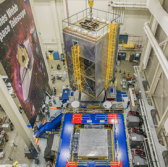 NASA has restarted vibration tests on the James Webb Space Telescope after demonstrations shut down early on Dec. 3, 2016, due to sensor readings that went beyond predicted levels.
NASA has restarted vibration tests on the James Webb Space Telescope after demonstrations shut down early on Dec. 3, 2016, due to sensor readings that went beyond predicted levels.
The space agency said Wednesday an investigation revealed that the incident was caused by small motions of launch restraint mechanisms that keep one of JWST’s mirror wings folded-up.
“Now that we understand how it happened, we have implemented changes to the test profile to prevent it from happening again,” said Lee Feinberg, JWSTÂ optical telescope element manager at NASA’s Goddard Space Flight Center.
Feinberg added the JWST team uses diagnostic tests to determine how the ground vibration test is “more severe” than the actual launch vibration environment.
The team comprised of NASA Goddard, Northrop Grumman, Orbital ATK, Ball Aerospace, European Space Agency and Arianespace finished vibration tests along one axis and will continue to shake the telescope in two other directions.
Raytheon has completed factory acceptance tests on JWST’s ground control system.
NASA also works with ESA and Arianespace to confirm whether the adjustments made to the telescope’s vibration tests mirror the launch vibration environment and provide some margin.
The space observatory is on track and within budget for a 2018 launch, NASA noted.




